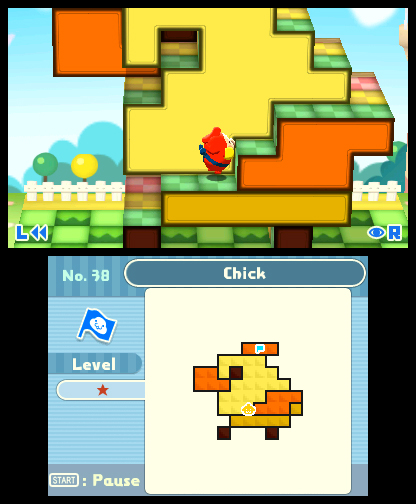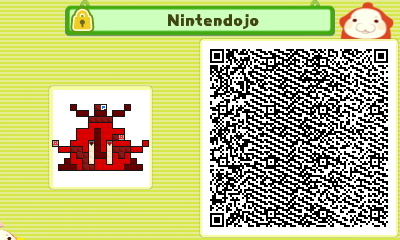Deceptively simple puzzle-platform gameplay; over 250 puzzles, with player-generated content; colorful art direction
No online puzzle sharing
I don’t normally share my colleagues’ love of quirky puzzlers, but if there’s a game that challenges– really challenges— my reservations against puzzle games, Pushmo is it. With this game, Nintendo eShop is finally coming into its own.
Old-fashioned pixel-by-pixel spriting has constantly pervaded video games, but in the past decade, pixel art has appeared in everything from Bryan Lee O’Malley’s Scott Pilgrim graphic novels (and their film adaptation and video game adaptation and probably cereal adaptation one of these days) to Habbo Hotel to every major news outlet ever. (Not really.) The renaissance has hit video games, too, of course– Mega Man 9 and Cave Story 3D certainly exemplify Videogameland’s love for pixels in the Nintendo world, while 3D Dot Game Heroes and Minecraft provide even more opportunities for players to revel and share in the power of the pixel.
Pushmo on the other hand may not be as deeply mired in pixel art as other games, but the influence shows. The game tasks players with pulling and pushing out blocks, climbing uphill in order to reach the top, where a child bawls for salvation. (If this reminds you of Atlus’ Catherine, you’re not too far from the truth– except that Pushmo focuses less on gory impalement and more on adorable puzzling/platforming.) Because, unlike Catherine‘s spike-evading, cliff-hanging protagonist, Pushmo‘s Mallo (not the prince— sorry SMRPG fans) can only jump and push/pull blocks, learning to play the game is very simple. And for the same reasons, the only obstacles in your way are the ones you make yourself. Fortunately, holding the R button gives you a full view of the puzzle so you can make some intelligent moves, and when you make a silly one, the L button allows Prince of Persia: Sands of Time-esque rewind.
Initially, though, you won’t find much in your way while trying to save those silly kids. Pushmo‘s first levels remind of Picross DS‘s introductory stages– they’re tricky sometimes, yes, but once you figure out the fundamentals they go down quickly. (Or is that pushed/pulled out quickly?) It’s constant playtime for the first thirty stages or so (there are over 250 official ones), and the miracle is, it remains constant playtime even until the very end of the the game. How this happens is unclear. Like, say, a good Mega Man game, Pushmo challenges players to keep trying different combinations of manipulation and movement to get to the end, and even though players may huffily close the 3DS on a particular difficult level, they’ll more often than not pick up the 3DS for another round later. They’ll go up and down those giant towers over and over again, on both sides, until they reach the top– and are rewarded with heaping amounts of satisfaction.

Climbing baby animals has never been so fun.
In this way it’s great that Pushmo is on a handheld rather than on a console, and even greater that it’s for 3DS. Many of the stages in Pushmo are simple arrangements of blocks, but quite a few are “murals”– like in Picross DS, or, yes, 3D Dot Game Heroes, Intelligent Systems have repurposed childhood memories in the form of kittens, treehouses and Super Mario Bros. to climb once again. Beating each stage is pure joy, symbolizing our ascent beyond our childhood years– or perhaps how they stay with us constantly, only even more vivid than before. The three-dimensional effect certainly helps, especially in the later stages, where you’ll have almost forgotten which blocks you’ve pushed and pulled already in a no-doubt gigantic canvas, even though they’re all of different colors. And as you literally pull once-flat images to the third dimension, you’ll feel like one of those newfangled pixel artists– one who works in both second and third dimensions.

Can you solve the official Nintendojo Pushmo? (Not that hard because Andrew is bad at this.)
Even after you solve all of Pushmo‘s built-in puzzles, there’s still potentially infinite ones left in the form of player-created content. While Pushmo doesn’t support Nintendo Wi-Fi Connection for sharing puzzles, players can convert their puzzles into a QR code, which can then be shared with their friends. (Check out our Nintendojo puzzle above, by the way! Though it probably shows how inept I am at puzzling.) Fortunately, Intelligent Systems has guarded against unsolvable puzzles– players can only make QR codes out of their puzzles after they solve it themselves. Meanwhile, the developers have already created three new puzzles online; there’s no telling what those other crazy gamers out there will do.
As you climb up and down those oft-saccharine, never-malevolent stages in Pushmo, it’s easy to wonder why it never burns out. Maybe it’s that the puzzles are never diabolical to the point of total disgust. Maybe it’s the perseverance of Mallo, whose arm-flailing jumps never get old. Or maybe it’s just because climbing up Yoshi or Super Mario reminds you too much of why you play video games, of why you play games like Pushmo— and knowing this, you can’t just stop playing. You’ve got memories to rebuild.




 ShareThis
ShareThis







A-? WHAT? WHOA WHOA WHOA WHOA WHOA!
This game is an A+. You CAN share online, just use the browser to go to http://pushmo.3dsfans.com/ and you can post the QR codes straight to the site from your 3DS.
Alright, alright, but you can’t do it straight from the game– like I said, it’s up to players :)
eShop related news here… SWAPNOTE is on the eShop, fools!
I’m NOT a fool! Can’t wait to get Pushmo!
This game is awesome!! Probably one of the best downloadable games I’ve ever downloaded. Come to think of it, we should make an article where the editors share some of their Pushmo creations or something..?